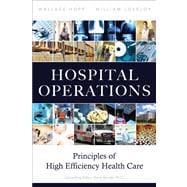
What is included with this book?
Wallace Hopp, Herrick Professor of Manufacturing and Alessi Professor of Operations and Management Science at U. of Michigan's Ross School of Business, researches design, control, and management of production, supply chain, and work systems. Formerly Editor-in-Chief of Management Science, his clients have ranged from Eli Lilly to IBM. William Lovejoy is Raymond T. Perring Family Prof. of Business Administration and Prof. of Operations and Management Science at the Ross School of Business. He researches management across functional boundaries, innovation, and healthcare; his courses have been covered by The Wall Street Journal and The New York Times.
1 INTRODUCTION TO HOSPITAL OPERATIONS 1
1.1 Stakeholders’ Perspectives 1
1.2 A Metaphor for Hospital Operations 3
1.3 Health Care in Crisis 4
1.4 A Focus on Practice 7
1.5 The Time Is Now; The Tools Are Known 9
1.6 Principles-Driven Management: Marrying Theory and Practice 13
1.7 The Structure of This Book 15
1.8 References 19
2 EMERGENCY DEPARTMENT 21
2.1 Stakeholders’ Perspectives 21
2.2 Introduction to the ED 29
2.3 Managing the ED 42
2.4 Key Management Issues in the ED 48
2.5 Conclusions 112
2.6 Stakeholders’ Perspectives 113
2.7 References 117
3 NURSING UNITS 127
3.1 Stakeholders’ Perspectives 127
3.2 Introduction to Nursing Units 137
3.3 Managing a Nursing Unit 153
3.4 Key Management Issues in a Nursing Unit 160
3.5 Conclusions 235
3.6 Stakeholders’ Perspectives 236
3.7 References 240
4 OPERATING ROOMS 243
4.1 Stakeholders’ Perspectives 243
4.2 Introduction to the OR 248
4.3 Managing the OR Suite 263
4.4 Key Management Issues in the OR 271
4.5 Conclusions 332
4.6 Stakeholders’ Perspectives 333
4.7 References 336
5 DIAGNOSTIC SERVICES 339
5.1 Stakeholders’ Perspectives 339
5.2 Introduction to the Diagnostic Units 344
5.3 Managing a Diagnostic Unit 370
5.4 Key Management Issues in the Diagnostic Units 376
5.5 Conclusions 449
5.6 Stakeholders’ Perspectives 450
5.7 References 457
6 HOSPITAL OF THE FUTURE 463
6.1 Stakeholders’ Perspectives 463
6.2 Product and Process Integration 466
6.3 Looking to the Future 476
6.4 Management Challenges 481
6.5 Final Message 495
6.6 References 496
Appendix A MANAGEMENT PRINCIPLES 497
Appendix B HISTORICAL JUSTIFICATION FOR AND DEVELOPMENT OF STANDARD BED/POPULATION RATIOS 589
Index 595
The New copy of this book will include any supplemental materials advertised. Please check the title of the book to determine if it should include any access cards, study guides, lab manuals, CDs, etc.
The Used, Rental and eBook copies of this book are not guaranteed to include any supplemental materials. Typically, only the book itself is included. This is true even if the title states it includes any access cards, study guides, lab manuals, CDs, etc.